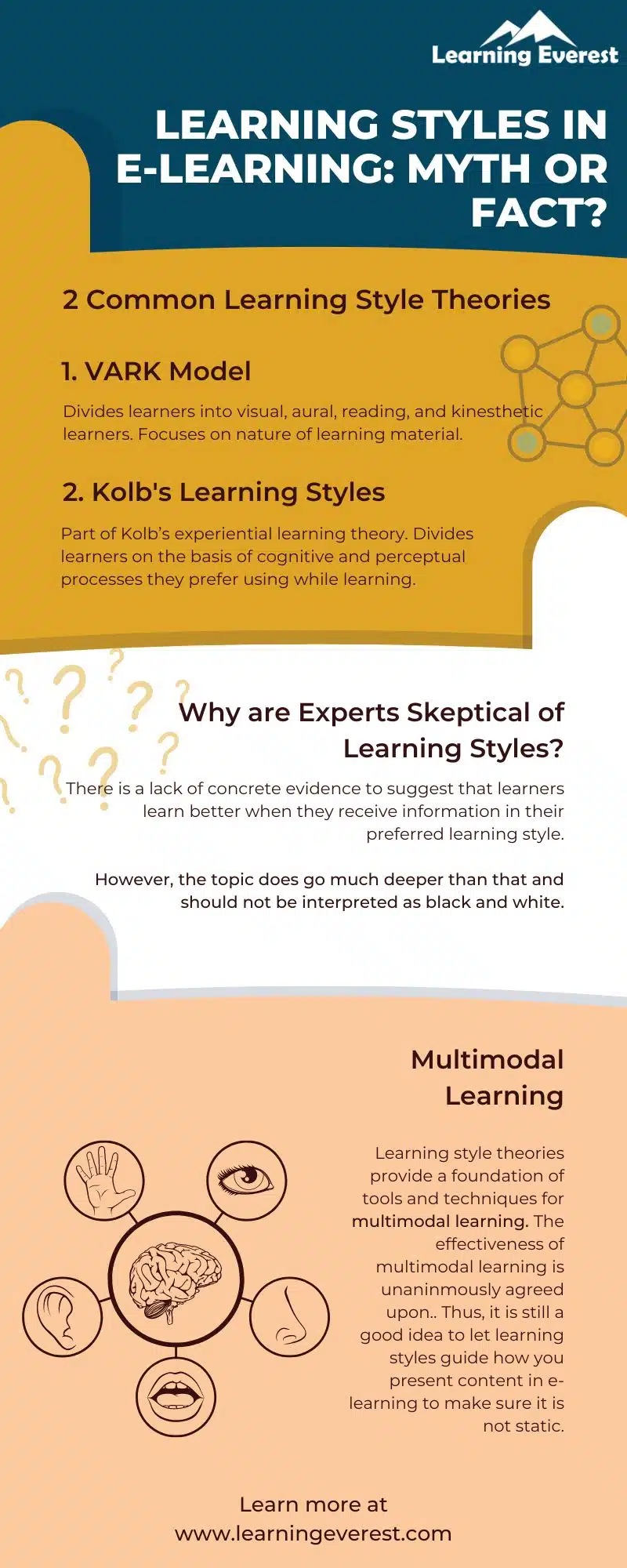Learning styles in e-learning have become a common topic of consideration in L&D today. Learning styles are people’s behaviors and preferences for taking in information that are believed to make learning more effective for learners. Countless learning style frameworks exist, each offering distinct perspectives on how people learn. However, learning styles have also sparked considerable debate among experts regarding their actual impact on learning.
Table of Contents
So, what learning style is best for online learning? This article will look at two learning styles and explore whether incorporating learning styles in e-learning is necessary or not.
Learning Style No. 1: The VARK Model
The VARK model is the most commonly followed approach to understanding different learning styles. VARK is an acronym for the different kinds of learners listed in this approach.
- Visual Learners – as the name reflects, visual learners learn best with the help of visual stimuli. Diagrams, charts, tables, color-coded gradients, graphics, animations, and other visual media are the best ways to communicate information to them.
- Aural Learners – aural learners or auditory learners are best at processing information by hearing. Listening to lectures, podcasts, audiobooks, and voiceovers are some ways in which they best take in learning material.
- Reading Learners – reading learners prefer learning presented in the form of text. Books, papers, written stories, manuals, brochures, presentations, etc. are the best methods to relay information to them.
- Kinesthetic Learners – this category of learners needs to engage with information using their bodily senses. In other words, they learn by experiencing and doing things themselves. Performance-based activities, demos, hands-on learning, field tours, etc. are some of the options you have for teaching this type of learner.
Learning Style No. 2: Kolb’s Learning Styles
As a contrast, let us also look at Kolb’s learning styles which take a different approach to learning. These learning styles are a part of Kolb’s experiential learning theory. While these learning styles work together in Kolb’s model, people often tend to be more comfortable with one learning style or cognitive processing style over others. The learning styles in Kolb’s model are as follows:
- Diverging Learners – These learners prefer to learn by taking in visual and auditory information and forming a big picture based on the information they gather.
- Assimilating Learners – This type of learner learns by drawing connections between concepts and forming frameworks and models that represent how different information fits and functions together. Their primary preference for taking in information is through observation.
- Converging Learners – Converging learners like to get to the bottom of new information and figure out its core. They can then use this knowledge and apply it to practical situations. Converging learners, are thus, great problem solvers and have a knack for applying abstract information to the real world.
- Accommodating Learners – Accommodating learning is learning by doing. This group of learners is very hands-on and learns best by experiencing rather than dealing with conceptual or theoretical information.
Each of these learning styles has a combination of two out of four learning approaches at its core. These approaches form the processing and perceiving continuum of how our brains handle information. These approaches are:
- Concrete experience (hands-on experience)
- Reflective observation (observing and thinking about the information)
- Abstract conceptualization (forming mental frameworks and models of information)
- Active experimentation (applying the information to different situations)
The Need or Lack Thereof of Learning Styles
While VARK focuses on the nature of learning materials that work best for learners, Kolb’s learning styles talk about the cognitive processes that aid learning for different individuals.
Now that we have looked at these two approaches, let us revisit the debate surrounding learning styles. There is skepticism among L&D professionals and educational psychologists regarding learning styles because there is a lack of concrete evidence to suggest that learners learn better when they receive information in their preferred learning styles.
However, the topic goes a bit deeper than that. Despite the lack of evidence, its interpretation is not as black and white within the L&D community. Instead, experts seem to unanimously agree that learning is multimodal.
In other words, while people undoubtedly have modalities that they find easier to process than others, information processing as a function requires several different forms of input to be effective. Learners cannot get the best out of static instructional materials that only cater to one sensory or cognitive modality. A balance of different kinds of input always produces better results.
That is why textbooks have diagrams, videos have voiceovers, screens have animations, and so on. In that sense, learning styles offer a trove of tools and combinations of stimuli that can be used to present the same information in different forms to learners.
The Implications of Learning Styles in E-Learning
E-learning, be it an infographic, a video, a full-fledged course, or a gamified activity, usually combines two or three modalities and is multimodal by default. This multimodality comes from an emphasis on interactivity and engagement to prevent e-learning from becoming a passive activity for learners. Learning style theories and the techniques and suggestions they propose are essential guidelines for instructional designers to make courses as accessible and interactive as possible.
Thus, to echo the previous section, despite the lack of evidence in support of learning styles, they are a valuable resource for making learning interesting and effective.
The bottom line, therefore, is that learning styles cannot replace other instructional design frameworks as they stand now, but they are vital supplementary approaches that enhance the process.
Infographics

Learning Styles in E-Learning Myth or Fact





